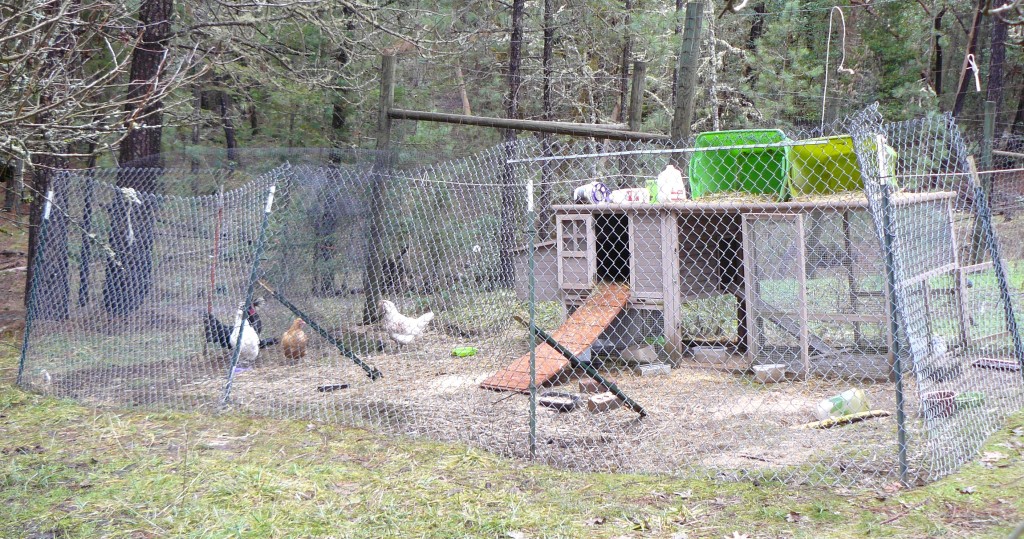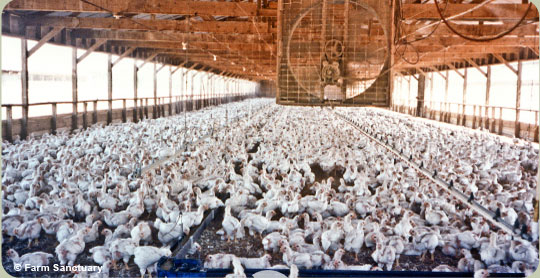There’s more to chickens that we realise!
 We have a rather run-down ‘home’ for our chickens close to the house. It was run-down before the snow fell and almost brought down the surrounding wire fence.
We have a rather run-down ‘home’ for our chickens close to the house. It was run-down before the snow fell and almost brought down the surrounding wire fence.
 But, hopefully, this coming Thursday sees a new walk-in run being constructed for our birds so they are better protected.
But, hopefully, this coming Thursday sees a new walk-in run being constructed for our birds so they are better protected.
So what has brought this topic to mind?
The answer is a recent item that appeared on the Care2 site about how badly we misunderstand chickens.
I thought you would enjoy reading it.
ooOOoo
6 Surprising Chicken Facts
Written by Katherine Martinko
It’s time we started paying attention to chickens, one of the most misunderstood and ignored species on Earth.
There was a time when chickens were viewed as exotic, fascinating birds. Descendants of exotic Asian jungle fowl, they were revered for their ferocity and intelligence, and domesticated around 8,000 years ago, more for cockfighting than eating. But then, we humans began eating them in ever-larger quantities, until we reached the point where we are now, with 20 billion (mostly white) chickens living in dirty, crowded barns, awaiting slaughter.
Chickens have been a part of human lives for millennia, and yet they are one of the most misunderstood, if not ignored, species on Earth. Lori Marino, an American neuroscientist and animal intelligence researcher, wants to change this. She is intrigued by the fact that chickens are so rarely recognized for their cognitive abilities and frustrated that studies about birds almost always focus on other, less-domesticated species, like crows and parrots.
“Arguably even the scientific community has been influenced by public perceptions of chickens as cognitively simple… This asymmetry in the literature is likely a reflection of, as well as a contributor to, the disconnect scientists and the public have between chickens as commodities and who they actually are as individuals.”
Chickens deserve more attention, and here are some quirky, interesting facts to get you thinking about chickens less as food and more as fascinating co-inhabitants of our world. These come via Marino’s recent paper, “Thinking Chickens,” published online in Animal Cognition in January 2017.
1. Chickens are a sub-species of the red jungle fowl that hails from southeast Asia.
The red jungle fowl (galls gallus) inhabit the edges of fields, scrubland, and groves. Domestication was well established 8,000 years ago, but some records suggest it could have started as much as 58,000 years ago.
2. Domestic chickens are similar to their wild counterparts.
Despite the intense breeding and genetic manipulation of recent years, chickens have not been cognitively or behaviorally affected by domestication. This stands in contrast to dogs and wolves, for example, which have diverged significantly due to domestication. Nor have chickens become less aggressive toward predators through domestication, which is a common outcome; in fact, some chickens are more aggressive even than red jungle fowl.
3. A chicken’s beak is highly sensitive to touch.
The beak, with numerous nerve endings, is used to explore, detect, drink, preen, and defend. This also means that when a bird is de-beaked, as often happens in industrial farming, it experiences great pain, sometimes for months, which changes its behavior. Marino writes, “At the end of the beak is a specialized cluster of highly sensitive mechanoreceptors, called the bill tip organ, which allows chickens to make fine tactile discriminations.”
4. Chickens have finely tuned senses.
They can see long distance and close-up at the same time in different parts of their vision. They can see a broader range of colors than humans. They can hear at low and high frequencies at a variety of pressure levels. They possess well-developed senses of taste and smell. They can orient to magnetic fields, like many other birds.
5. Chickens are surprisingly good at math.
Three-day-old chicks are able to perform basic arithmetic and discriminate quantities, always opting to explore a set of balls with the greater number, even when an object was visibly transferred from one set to another. Five-day-old chicks have been found to track up to five objects.
“When they were presented with two sets of objects of different quantities disappearing behind two screens, they were able to successfully track which screen hid the larger number by apparently performing simple addition and subtraction.”
6. Chickens can exercise self-control.
In an experimental setting, chickens have been given the choice between 2-second delay with 6 seconds of access to food, versus a 6-second delay with 22-seconds of access to food. The hens waited for the longer reward, “demonstrating rational discrimination between different future outcomes while employing self-control to optimize those outcomes.” Self-control usually doesn’t appear in humans until four years of age.
These are just a few of the remarkable discoveries described in Marino’s study, a highly readable, entertaining paper. It’s an important reminder that chickens, arguably the most ubiquitous animals in our world, deserve far more respect than they currently receive. Hopefully this will lead to more people questioning the horrific conditions in which most of them are kept.
Photo Credit: robertsharp/Flickr
ooOOoo
It’s easy to fall into the trap of looking for a humourous way to close today’s post. But a more responsible approach would be to repeat the words from the start of the article to serve as a reminder of trying, wherever possible, to think about the food we eat, especially when animals and birds have to be slaughtered to provide us with that food.
…. we reached the point where we are now, with 20 billion (mostly white) chickens living in dirty, crowded barns, awaiting slaughter.
 But please don’t leave this page until you have watched the following video.
But please don’t leave this page until you have watched the following video.
Published on Dec 3, 2014After 22 years of raising chickens for Perdue, one brave factory farmer Craig Watts was at his breaking point and did something no one has done before. He invited us, as farm animal welfare advocates, to his farm to film and tell his story. Ask your supermarket for Better Chicken at http://better-chicken.org.

Very informative blog, Paul. I really am embarassed to say that I didn’t know much about chickens. I did know they were intelligent. Thanks for bringing to our attention the unclean conditions of some chicken farms.
LikeLike
Susan, same here despite us having chickens as pets. Yes, one doesn’t want to ponder on how so many chickens are treated.
LikeLiked by 1 person
Thank you for this: Anything to bring the plight of these much maligned intelligent creatures to the public’s attention is welcome indeed. The atrocious conditions and the mutilations they suffer at the hands of disreputable farming practices doesn’t bear thinking about. We as humans have stopped treating the food we eat with respect, we turn a blind eye and we don’t want to know too many facts because it will upset us. Not good enough. If you love dogs and cats and would never dream of eating them, extend your love to all creatures. It’s the right thing to do. If my comment offends please delete it. I do feel strongly about this.
LikeLike
Barbara, your passion and devotion to animals shines out from your words. Thank you. They don’t even start to offend! Far from it!
LikeLike
Thank you Paul.
LikeLike
Thanks for sharing. Most enlightening .
LikeLike
Thank Tony. Very good to hear from you.
LikeLike
Thank you for sharing this. I really learned so much about chickens. I am so glad you decided to share this amazing information.
LikeLiked by 1 person
A pleasure! We, too, learned from it. Despite being vegetarians we do eat chicken. But the video has made us think twice about continuing that practice. Want to get to know more about the Better Chicken organization.
LikeLiked by 1 person
I have a marvellous blogging friend in New Mexico who has Rufina, a chicken who was shot in the head, sealed in a plastic bag, placed in a freezer for 24hrs, and lived! (albeit now blind).
I have a framed poster of Rufina up in my living room, and even one her feathers perched in one of my many, many, many St. Francis’s
Here’s the Huffington Post article on her
http://www.huffingtonpost.com/2014/08/14/zombie-chicken-freezer-alive_n_5675615.html
And here’s Laura’s first post on this gorgeous creature.
https://liveclayart.com/2013/06/24/the-undead-chicken/
LikeLike
Oh John,
What an incredible story. I would love your blogging friend to share a guest post with the readers of this place.
Thank you,
Paul
LikeLiked by 1 person
Contact her, she’s wonderful, and her pottery is to die for.
LikeLike
Got it, and will do!
LikeLiked by 1 person
Thank you for the connection, John! I am so honored! I hope you and your gaggle of St. Francisi are happy and well. ❤
LikeLiked by 1 person
For you, Laura, anything!
St. Francis might have to start crowd funding for us… We’re up to seven cats now and three dogs, with #4 probably being welcomed to her new (first) home next week 🙂
LikeLiked by 1 person
John, well done!
You do know that if you wanted to publish an appeal for more funds to support the work you are doing down there in Brazil, doing it via this blog would be a privilege!
LikeLiked by 1 person
We’re not even an NGO, Paul, although I might have start looking into that 😉
LikeLike
Wow! Exciting times in the Zande household. Good for you… welcome home #4!
LikeLiked by 1 person
As a long time vegetarian, I don’t have much experience with chickens beyond running like crazy when they chased me in the barn. I’m rather terrified of them! 🙂
LikeLike
Sounds as though you have some very healthy, happy chickens there! 🙂
LikeLiked by 1 person
They were thugs! 😂
LikeLike
😅
LikeLiked by 1 person
My daughter raises chickens. She has 20+, and two turkeys. We love having fresh eggs at our disposal. She just bought some “Silkies”, in the hopes that one is a rooster. She has a “Frizzle”, and to cross-breed them creates a “Sizzle”. My grandson has no fear, and is an excellent chicken catcher!
LikeLike
What a great article! Although I’ve researched a bit and lived with chickens for 3 yrs, I didn’t know about the beaks or the cognitive abilities. So fascinating. I also read at some point that they are genetically the closest living relatives to dinosaurs. Not sure which kind, but interesting. Thanks for spreading this valuable info around to your readers!
LikeLike
Laura, the thanks go to you for being so open and responsive to the connection that John offered.
LikeLike
And what a transformation you have made with your new Chicken Run.. as seen in your future post xxx
LikeLike
Yes, there is a slight difference between the ‘before’ and the ‘after’!
LikeLiked by 1 person
Just a little.. :-D… Looks great
LikeLike